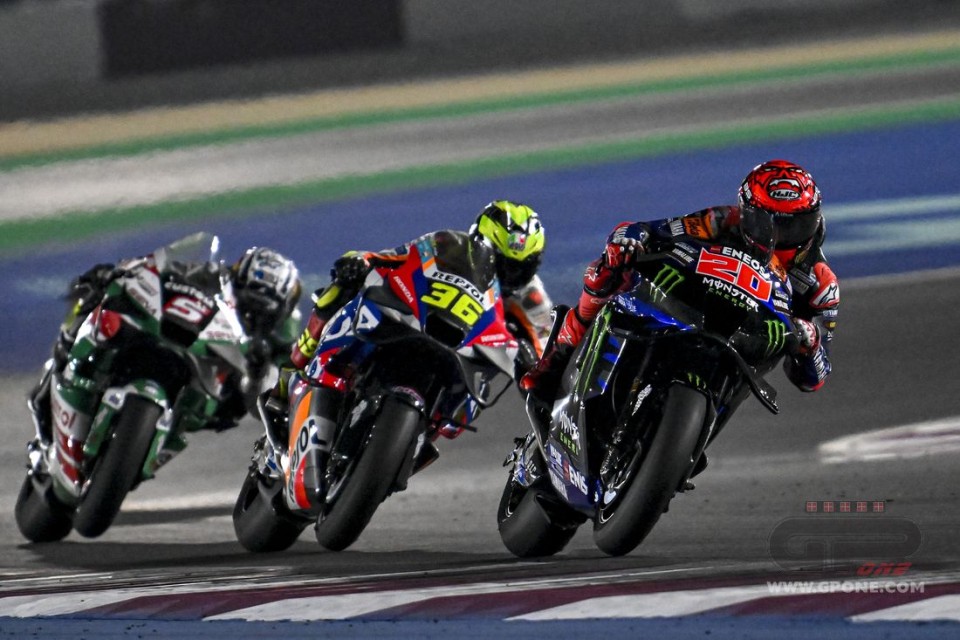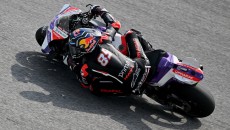Honda and Yamaha are both under special observation in this 2024 season. The two Japanese manufacturers are in great difficulty and the concessions are one way of helping them climb a slope, which remains very steep. While in Tokyo they have decided to revolutionize the RC231V, in Iwata they have focused on the arrival of new collaborators (from Marmorini to Bartolini, in addition to an agreement with Dallara). The two racing departments are therefore rolling up their sleeves, although it certainly does not take only a few months to go from zero to hero, and the first two Grands Prix have shown this. It is not only Ducati that they are far behind, but also Aprilia and KTM.
An analysis of the Qatar and Portimao GPs demonstrates this.
Qatar: the improvements are there, but they are not enough

The Losail GP was special because everyone improved their performance considerably from last season. Suffice to say that Martin lowered last year's pole position time by almost a second and was 10 seconds faster in the Sprint. The race was shortened by one lap due to Raul Fernandez's problem at the start (which is why you will not find a direct comparison in the table above, as Rins, who had not taken part in the GP in 2023, is missing), but even in the latter case we can speak of an improvement in the order of 16 seconds. Such a jump is certainly due to the technical evolution of the bikes, the new compounds brought by Michelin, and above all an asphalt that was performing at its best after being resurfaced last year.
The M1 and RC213V also improved, but not enough. Indeed, the 6-tenths difference between 2023 and 2024 moved Quartararo further away from the pole position time: while last year he was about 8 tenths away, in the first GP of this season he went to about 1.2". In a nutshell: the step forward was there, but that of the rivals was bigger. The same goes for the Sprint time: the Frenchman's nearly 5-second improvement is half that of Martin's. In fact, Fabio failed to score points.
At Losail, the Honda - while remaining behind the M1 in the standings - did better. In qualifying Mir took a second and a half off his 2023 time, Nakagami even more than 2. Same in the Sprint, with Joan almost 26 seconds faster than a year earlier and Takaaki almost 15. It is Zarco who is the litmus test, because the Frenchman on both the flying lap and the short race did better than on the Ducati. The bottom line is that by starting from so far back, this progress did not mean an equally noticeable jump in the standings.
It's a separate matter for Luca Marini, who only a few months ago on the Ducati had taken pole and finished on the podium at Losail. His deterioration is due in part to the fact that he is on a much less competitive bike than the Desmosedici, but also from the fact that he has not yet adapted to the RC213 and his times have in fact been much slower than those of his brandmates, as was also the case in Portimao.
Portugal: Europe starts uphill

In Portimao, the weather got in the way of the MotoGP riders, who found a track in less than optimal conditions in qualifying. Bastianini, in fact, took pole by lapping about half a second slower than Marquez did in 2023 qualifying. That is why Quartararo's 4-tenths deterioration is positive and in fact Fabio started on the 3rd row for the GP. Rins' difference, on the other hand, refers to when he was riding the Honda, and - offset by the track conditions - it can be argued that Alex did better on the M1. Although Marc had put the RC213V on pole in 2023, the 2024 Honda on the flying lap certainly did not shine: Mir was almost a second worse, Nakagami more than 6 tenths. The 1.1" abundant difference from Zarco's 2023 mark explains more than a thousand words what the distance from Ducati is. The case of Marini is exemplary in this regard: he was almost 2 seconds slower on the flying lap.
In the Sprint the asphalt had improved and Vinales was 3 seconds faster than last year's winner Bagnaia. Quartararo, in this case, only 1.6", a sign that the M1 has not progressed enough. Nakagami, on the other hand, improved his time by almost 5 seconds, a good result. Unfortunately, Mir had seen the finish line last year, because it was his best performance among the Honda riders in the short race, and it would have been interesting to have a comparison.
It was in the long race, however, that the pains came for the Japanese. Martin's race time this year was a full 7 seconds lower than Bagnaia's last year, the Japanese bikes, on the other hand, all showed the plus sign. Over the long distance Quartararo and Mir contained the damage, but they were more than 4 seconds slower than a year ago, Nakagami even 10. Switching from Honda to Yamaha Rins lost 12 seconds, almost 23 those of Zarco coming from Ducati.
Concessions may help to speed up the Japanese manufacturers' improvement, but it will certainly take a long time to reduce a gap that still appears huge.











